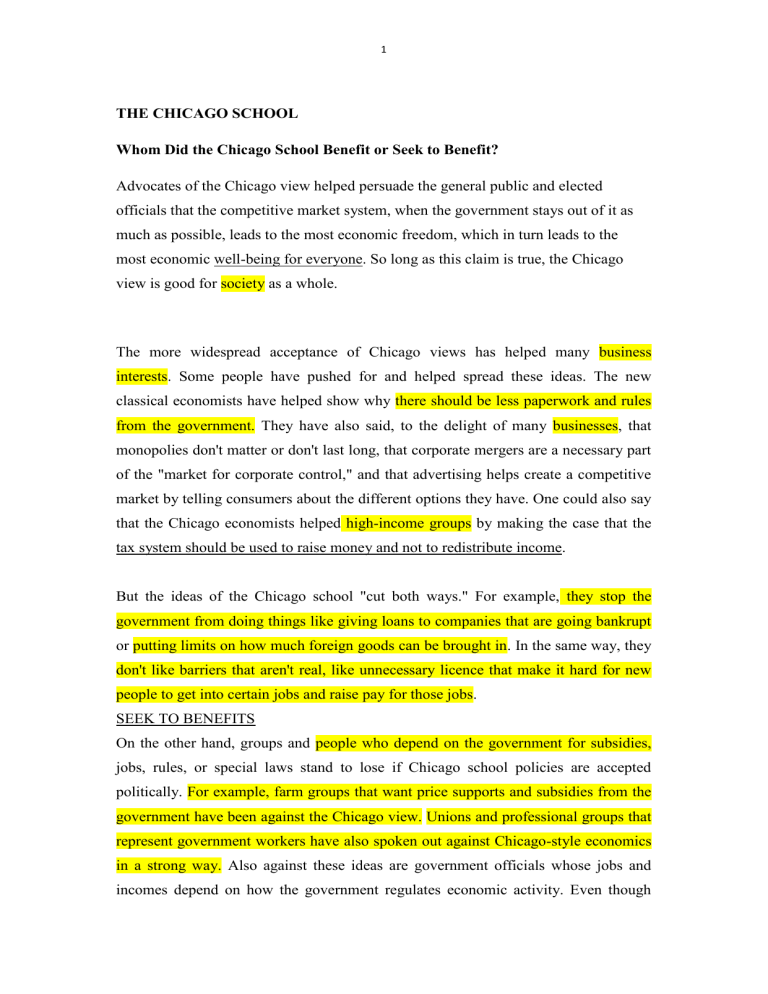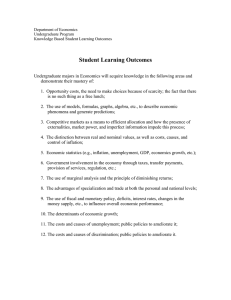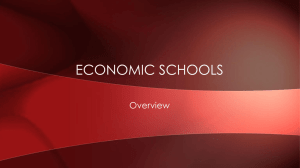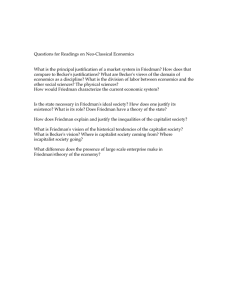Chicago School of Economics: Benefits, Criticisms, and Contributions
advertisement

1 THE CHICAGO SCHOOL Whom Did the Chicago School Benefit or Seek to Benefit? Advocates of the Chicago view helped persuade the general public and elected officials that the competitive market system, when the government stays out of it as much as possible, leads to the most economic freedom, which in turn leads to the most economic well-being for everyone. So long as this claim is true, the Chicago view is good for society as a whole. The more widespread acceptance of Chicago views has helped many business interests. Some people have pushed for and helped spread these ideas. The new classical economists have helped show why there should be less paperwork and rules from the government. They have also said, to the delight of many businesses, that monopolies don't matter or don't last long, that corporate mergers are a necessary part of the "market for corporate control," and that advertising helps create a competitive market by telling consumers about the different options they have. One could also say that the Chicago economists helped high-income groups by making the case that the tax system should be used to raise money and not to redistribute income. But the ideas of the Chicago school "cut both ways." For example, they stop the government from doing things like giving loans to companies that are going bankrupt or putting limits on how much foreign goods can be brought in. In the same way, they don't like barriers that aren't real, like unnecessary licence that make it hard for new people to get into certain jobs and raise pay for those jobs. SEEK TO BENEFITS On the other hand, groups and people who depend on the government for subsidies, jobs, rules, or special laws stand to lose if Chicago school policies are accepted politically. For example, farm groups that want price supports and subsidies from the government have been against the Chicago view. Unions and professional groups that represent government workers have also spoken out against Chicago-style economics in a strong way. Also against these ideas are government officials whose jobs and incomes depend on how the government regulates economic activity. Even though 2 many of the more recent economists from the Chicago school are not interested in politics, the school as a whole did a lot to help conservatives in the United States. As Melvin W. Reder, a member of the Chicago school himself, said: 1. The Chicago School's tremendous success in the third quarter of this century was largely a result of its ability to play a leading role in both scientific research and the promotion of political conservatism. 2. Due to Friedman and Stigler's and their lucky mix of scientific ability and explanatory competence, as well as probably even more so due to the bankruptcy of After World War II, there was an intellectual conservatism. 3. The political right had very little intellectual backing as a result of the Great Depression's ability to discredit laissez-faire capitalism and Hitler's ability to cast doubt on any form of nationalistic-conservative theory. 4. Although there were other advocates of laissez-faire (such as the Mises group), [the Chicago economists] had a significant advantage in the decades that followed 1945 when competing for the attention and support of the conservative public due to their high professional standing, academic positions, and proficiency in non-technical communication. 3 How Was the Chicago School Valid, Useful, or Correct in Its Time? 1.Preserve the legacy of Classical, Marginalist and Neo-Classical Economics Chicago school maintained and strengthened the marginalist tradition at a time when it had diminished popularity. It helped preserve the long legacy of classical and Neoclassical economics, while the Keynesian revolution was dominating the intellectual scene. Economists have once again turned to microeconomics analysis to expand their insights into the issues of the day, including those that previously seemed to be the exclusive domain of macroeconomic theorists. Example; the analysis of unemployment now includes emphasis on the microeconomics theories of job search and inter-temporal substitution between work and leisure. 2. Keeping Alive The Monetary Views Of Fisher Fisher monetary view could have become permanently buried by the weight of Keynesian ideas. The rapid inflation of the 1970s and early 1980s turned the nations attention away from the main concern of Keynesianism (unemployment) -concern of Fisher and Friedman (inflation) The simultaneous economics problem led many Keynesians to call for incomes policies, although they acknowledged that such policies would likely produce negative side-effects on efficiency. The new classicists arguing - long-run trade-off between inflation and employment was illusory, preserved the optimistic classical perspective that economic efficiency, price stability and a natural rate of full employment are mutually attainable. Which Tenets of the Chicago School Became Lasting Contributions? Major Tenets 1. Mathematical Orientation(Using both the marshallian partial equilibrium method and the walrasian general equilibrium) 2. Rejection of Keynesian (The economy is self adjusting and regulating with minor fluctuations being self-limiting) 3. Limited Government (Government regulations normally benefits those who seek the regulations) 4 The New Classical Ideas Have Already Penetrated Deeply Into The Curriculum Of U.S. Universities. 1.Discussions of a natural rate of unemployment, rational expectations, a long-run vertical Philips curve and short run versus long-run aggregate supply. 2.The Chicago theories of human capital, household production, job search and discrimination all are discussed within textbooks on contemporary labor economics. 3.The case for flexible foreign exchange rates is standard fare in international economics textbooks. 4. The Coase theorem of externalizes, although still controversial, is treated in textbooks on public finance and environmental economics. The Coase theorem of externalities is A theory that bargaining between individuals or groups over property rights will lead to an optional and efficient outcome 5 GARY S.BECKER IDEAS / THEORIES DISCRIMINATION Gary Baker is a sociologist and professor who has studied discrimination and its effects on various marginalized groups. One of his key theories is that discrimination operates at both individual and institutional levels, and that it creates and perpetuates inequality through a variety of mechanisms. At the individual level, discrimination can take the form of prejudice, bias, and stereotype-based behaviors, which result in unequal treatment of individuals based on their race, gender, sexual orientation, or other identity characteristics. At the institutional level, discrimination operates through policies, practices, and norms that reinforce and normalize existing inequalities, such as discriminatory hiring practices, unequal pay scales, and a lack of representation in leadership positions. Baker argues that addressing discrimination requires a multi-faceted approach that addresses both individual attitudes and institutional structures. This may involve education and awareness-raising initiatives, as well as the implementation of antidiscrimination laws and policies that address the root causes of inequality and create more equitable outcomes. Overall, Gary Baker's theory highlights the interconnections of discrimination and its impact on individuals and society, and underscores the importance of addressing both individual biases and systemic inequalities in order to create a more just and equitable world. The demand for preferred personnel will be higher than it would be without the preference for discrimination if the broader economy has positive discrimination coefficients. As a result, preferred workers will be paid more on the market than equally productive unpreferred ones. This fact has a significant implication: Companies who discriminate will pay greater wages than employers who do not. Businesses that practise discrimination will be required to pay a salary premium or 6 "price" for their preferences. Employing the equally productive unpreferred workers at the lower wage gives companies that lack this taste for discrimination—or whose preference is low compared to the wage differential—a cost advantage over their discriminating rivals. Theoretically, in a competitive market economy, only the lowest-cost producers can remain over time; discriminators will have average costs that are higher than the market-determined price, which means they will experience losses. Therefore, Becker's thesis is in line with the more comprehensive New Classical perspective: Long-term costs imposed by the competitive market system on discriminators will lead to a decline in all forms of discrimination, including those based on gender, ethnicity, and religion. The government's responsibility in accelerating this process should be to defy interest group efforts to obstruct the freedom of occupation choice. INVESTMENT IN HUMAN CAPITAL Gary Baker's theory of investment in human capital argues that individuals, governments, and organizations should invest in the development of human capital as a means of promoting economic growth and prosperity. Human capital refers to the knowledge, skills, abilities, and other attributes that individuals bring to the workforce and contribute to their productivity and earning potential. According to Baker, investment in human capital can take many forms, including education and training, health and wellness initiatives, and support for career development. He asserts that these investments can have a significant impact on an individual's earning potential and quality of life, as well as the overall health of the economy. Baker argues that investment in human capital is particularly important in today's rapidly changing global economy, where technological advancements and globalization are rapidly transforming the nature of work and the skills that are required for success. He believes that investment in human capital is a key factor in ensuring that individuals and organizations are able to adapt and thrive in this rapidly changing environment. 7 In addition to promoting individual success, Baker argues that investment in human capital can also contribute to the overall well-being of society, by creating a more educated and skilled workforce, reducing income inequality, and promoting economic growth. He argues that investment in human capital should be a top priority for governments and organizations, as it is essential for creating a more prosperous and sustainable future. Overall, Gary Baker's theory on investment in human capital emphasizes the importance of investing in individuals and the development of their skills and abilities as a means of promoting economic growth and prosperity, both at the individual and societal levels. THEORY OF THE ALLOCATION OF TIME Gary Baker's theory of the allocation of time suggests that individuals and organizations allocate their time and resources in ways that reflect their priorities and values. According to Baker, the allocation of time is a key factor in determining an individual's or organization's level of success and well-being, as it impacts their ability to achieve their goals and fulfill their responsibilities. Baker argues that the allocation of time is shaped by a variety of factors, including personal values and priorities, societal expectations, and organizational culture. He suggests that individuals and organizations can optimize their allocation of time by aligning their priorities and values, and by making conscious and deliberate decisions about how they allocate their time and resources. In addition to the impact of individual and organizational priorities and values, Baker also recognizes that external factors, such as economic conditions, technological advancements, and social and political changes, can influence the allocation of time. He argues that individuals and organizations must be flexible and adaptable in their allocation of time in order to respond to these changing circumstances and achieve their goals. Baker believes that the optimal allocation of time is a key factor in promoting individual and organizational success, and that individuals and organizations that allocate their time and resources in ways that align with their goals and values are likely to experience greater levels of satisfaction and well-being. 8 Overall, Gary Baker's theory of the allocation of time emphasizes the importance of aligning personal values and priorities with the allocation of time and resources, and recognizes the influence of external factors on this process. It highlights the need for individuals and organizations to make conscious and deliberate decisions about how they allocate their time and resources in order to achieve their goals and fulfill their responsibilities ON THE FAMILY 1.THEORY OF MARRIAGE Marriage allows for a division for labour that enables partners to maximize their joint production and consumption of commodities Normally, "positive sorting" between "high quality" man and female develops during marriage. The complementary nature of production is the factor. The beneficial characteristics of one partner boost their marginal contribution to generate full income. 2. FERTILITY Families produce children, which add to the family's full income, or economic welfare. But families do not produce as many children as would be biologically possible because they are costly. As wage opportunities increase for women, the price of each child increases (the opportunity cost rises). Parents opt to have fewer, but "higherquality" (healthier, better-educated) children. 3. ALTRUISM A person is altruistic when her or his utility increases because someone else's utility rises. Altruism adds to the potential gains from marriage, because consumption of a commodity enables utility to rise by more than the rise in utility to the consumer. One family member's joy adds to other family members' joy. Becker's theorem states that altruism in the family will tend to overcome selfishness. Translated: Even the most troublesome children won't want to do anything that could reduce their potential inheritance. Each beneficiary, no matter how selfish, maximizes the family income of his benefactor. 9 Selfish kids recognize that harming the family comes at the expense of harming themselves. But the restraining effect of altruism on self-interest diminishes with the number of benefactors. The idea here is that an action that reduces the family's full income will result in the altruistic head of the family having less full income to transfer. 4.DIVORCE Divorce are more likely early in the marriage than later because accumulation of information occurs during the first few year of marriage. The increase in the market productivity of women reduces the gains from specialization and increases the QUESTION Use Becker’s theories to explain each of the following: (a) Discrimination will be costly to a firm operating in a competitive environment. (b) Young people on average receive more schooling and on-the-job training than older people. (c) The number of meals consumed at restaurants in the United States has increased more rapidly than the number consumed at home. (d) Altruism adds to the potential gains from marriage. ANSWER: (a) According to Becker's theories, discrimination will be costly to a firm operating in a competitive environment because it will lead to the firm losing out on the best workers, who may be discouraged from applying due to the discrimination, and thus reducing its efficiency and productivity. In addition, the firm may incur legal costs and reputation damage if the discrimination is brought to light. (Becker, 2019) (b) Becker's theories suggest that young people on average receive more schooling and on-the-job training than older people because of the higher returns to these investments for young people, who have longer periods of time to benefit from them. This is due to the higher productivity gains from education and training, which are 10 likely to be larger when young people are involved, as well as the lower costs associated with offering such investments to young people. (Becker, 2019) (c) According to Becker's theories, the number of meals consumed at restaurants in the United States has increased more rapidly than the number consumed at home because of the convenience of eating out, which is especially attractive for working individuals who may not have the time or energy to prepare meals at home. Additionally, there is a higher level of leisure-time activities associated d) Becker's theory of the family and household explains that altruism adds to the potential gains from marriage by explaining that individuals benefit from exchanging goods and services within the household as well as from mutual support and companionship. This theory suggests that altruistic behavior, such as caring for a spouse, can increase the potential gains from marriage by reducing the costs of household production and increasing the overall well-being of both partners MILTON FRIEDMAN 1. Milton Friedman was one of the most influential economists of the 20th century and a key figure in the development of the Chicago School of economics. 2. His primary contribution to the field of economics was his monetarist philosophy, which argued that the money supply was the primary determinant of economic activity. 3. He also believed in free markets and advocated for deregulation and a free-floating exchange rate system. 4. Friedman's views on monetary policy were based on his belief that the government should not be involved in the money supply and that the money supply should be determined by the market, not by government intervention. 5. He was also a strong advocate for tax cuts, believing that lower taxes would lead to increased economic growth. 11 6. His theory of the "natural rate of unemployment" argued that there was a point where, even with full employment, wages and prices would not rise further since the economy was at full capacity. 7. He argued that an economy could operate at full employment without inflation, provided there was enough aggregate demand and that the money supply was not increased too quickly. 8.Friedman also argued that inflation was caused by increases in the money supply, and not by the demand. Some key ideas associated with the Chicago School include: Neoliberalism: The Chicago School is associated with neoliberalism, which is a political and economic ideology that prioritizes individual freedom and marketoriented policies. Methodological individualism: The Chicago School argues that economics should focus on the behavior and decision-making of individual actors rather than aggregates like firms or industries. Free market economics: The Chicago School supports the idea that markets are the best means of allocating resources and producing outcomes that serve the interests of society as a whole. Price mechanism: The Chicago School believes that prices, determined by the interactions of supply and demand, serve as the main mechanism for coordinating economic activity and allocating resources. Efficiency: The Chicago School emphasizes that market outcomes are efficient and that intervention in markets should be limited to promote efficiency and prevent market failure. MILTON’S IDEA/THEORY 1. Consumption Function 2. Monetary Theory 3. Economic Liberalism 12 13 CONSUMPTION FUNCTION In 1957, Friedman published a Theory of The Consumption Function book, he suggested that The Keynesian Consumption Function is too simplistic. Household's consumption determined by permanent income rather than current income, where permanent income is defined as the average income (people expect to receive over a period of years) Changes in income that considered to be temporary will neither greatly increase nor decrease people's present consumption .It responds only to changes in income that people view to be permanent and long-lasting Implication: Marginal propensity to consume out of changes in current income is smaller than the Keynesian theory would suggest. MONETARY THEORY THE DEMAND FOR MONEY (i) Total Wealth Including human capital, measured by permanent income, Permanent income Increases, the amount of money people desire to hold as cash balances also increases (il) Cost of Holding Money increase costs, decrease money being held. Costs vary with interest rate, the expected rate of inflation,and the price level. (in) Preferences Basic attitudes, holding and using cash Remain relatively constant "over significant stretches of space and time" 14 MODERN QUANTITY THEORY OF MONEY Friedman says that in the short run, the demand for money is pretty stable. The Fed System controls how much money is in circulation. If the number of dollars in circulation goes up, people will have more cash than they need. They will spend cash and write checks to try to get rid of these extra transaction assets. (literally about bekalan wang) But the community as a whole can't get rid of its extra cash because when one person spends money, it ends up in the billfold or chequebook of someone else. So, people trying to get rid of their cash balances will increase the demand for goods and services, which will increase production, prices, or a mix of both. -The demand of money increases because the community desire to hold additional money to buy the higher priced goods. -Inflation stated by Friedman, is always and everywhere a monetary phenomenon produced in the first instance by an unduly rapid growth in the quantity of money. So, Friedman says that the modern quantity theory of money is proven. It doesn't assume that velocity is constant, like the older quantity theory did. Instead, it says that the demand for money is "highly stable—more stable than functions like the consumption function that are offered as alternative key relations." 15 THE CAUSE OF THE GREAT DEPRESSION 1. Most economists at the time, including Keynes, thought that the Great Contraction in the United States happened even though the monetary authorities tried hard to grow the economy.They did their best, but it wasn't enough. 2. Recent studies have shown that the facts are exactly the opposite: the U.S. government's monetary policy was very deflationary. 3.During the contraction, the amount of money in the United States dropped by onethird. 4.And it went down not because no one wanted to borrow it .It went down because the Federal Reserve System forced or allowed a sharp drop in the monetary base. 5.This happened because it didn't do what the Federal Reserve Act said it should do to keep the banking system liquid. 6.The Great Depression is a sad example of how powerful monetary policy is, not how powerless it is, as Keynes and many of his contemporaries thought. THE LONG RUN VERTICAL PHILIPS CURVE Each short-run Phillips curve shows the combinations of inflation and unemployment that are possible when the actual rate of inflation diverges from the expected rate. When inflation is greater than expected, such as P2 rather than P1, unemployment temporarily falls below its natural rate (from Un to U1, as shown at b). But once P2 becomes the new expected rate, the short run Phillips curve shifts from SRPC1 to SRPC2 and the rate of unemployment returns to its natural level (point c). In the long run, said Friedman, there is no trade-off between inflation and unemployment. The long-run Phillips curve is vertical, indicating that any one of several rates of inflation is compatible with the natural rate of unemployment. 16 THE MONETARY RULE The Fed should stop making decisions about monetary policy on its own and stick to the monetary rule, which says that the money supply should grow every year at a steady rate roughly equal to the long-run rate of growth of capacity. There are four reasons why there needs to be such a rule. 1. How the Fed has done in the past. Friedman says, "Throughout the Fed's history, it has said that it was using its power to help keep the economy stable. But what we know doesn't back up this claim. On the other hand, the Fed has caused a lot of instability. 2. Limitations of economic knowledge.What we don't know about economics. There are time lags between changes in the amount of money in circulation and changes in output and prices, and these time lags vary and are hard to predict. Trying to fine-tune the economy is just as likely to make things worse as it is to fix them. 3Confidence. With a monetary rule, businesses, consumers, and workers would be able to sign contracts knowing that the Fed wouldn't change things on them later. 4.Neutralization."A monetary rule would protect monetary policy from both the random power of a group of men who aren't accountable to the voters and the shortterm pressures of partisan politics. 17 ECONOMIC LIBERALISM -He was reffering, to the economic liberalisme that we associate with the classical economists who emphasized economic freedom. -Over the years he advocated a series of reform that would place less reliance on goverment and more reliance on the market. -Friedman also say political freedom not only economic freedom. -Friedman's reform have been enacted liked proposals include an international system of flexible, market-determined foreign exchange rates. -Friedman's admires and critics alike agree that he helped establish that money 'matters' in the economy. -The also would agree that Friedman himself made a difference. QUESTION What are the major determinants of the demand for money, according to Friedman? Is this demand stable or unstable in the short run? How does an increase in the supply of money that exceeds the long-run growth of output cause a rise in the general price level? ANSWER According to Milton Friedman, the demand for money is primarily determined by three factors: transactions demand, precautionary demand, and speculative demand. Transactions demand refers to the demand for money to make payments for goods and services. This demand depends on the level of economic activity, which in turn depends on income and the price level. Precautionary demand refers to the demand for money to guard against unexpected changes in income or prices. This demand increases with income and the level of uncertainty. 18 Speculative demand refers to the demand for money as a store of value, which can be invested in financial assets. This demand depends on interest rates and the expected rate of return on alternative investments. Friedman believed that the demand for money is relatively stable in the short run but can become unstable in the long run. In the short run, changes in the supply of money affect mainly the price level, while in the long run, changes in the supply of money also affect output and employment. According to Friedman, if the supply of money increases at a rate that exceeds the long-run growth of output, the general price level will rise. This is because the increase in the supply of money leads to an excess supply of money, which puts upward pressure on prices. The rise in the price level reduces the real value of money and thus reduces the demand for money, which reduces the excess supply and eventually stabilizes the price level. Question Explain this quote by Friedman: “A rising rate of inflation may reduce unemployment, a high rate will not.” Answer This quote by Milton Friedman highlights his belief in the trade-off between inflation and unemployment in the short run, as expressed by the Phillips curve. According to this idea, there is a short-run negative relationship between inflation and unemployment, meaning that an increase in inflation can reduce unemployment and vice versa. However, Friedman argued that this trade-off is only temporary and cannot be sustained in the long run. He believed that a rising rate of inflation, no matter how low, would reduce unemployment in the short run by boosting expectations of higher nominal wages and encouraging more spending. But a high rate of inflation, which would result from continued increases in the money supply, would not reduce unemployment in the long run because it would erode the real value of money, reduce economic efficiency, and lead to higher nominal wages without corresponding increases in productivity. In essence, Friedman was saying that a modest and gradual increase in inflation can have a positive effect on unemployment in the short run, but once inflation reaches a high level, it will not continue to have this effect and will instead lead to negative economic consequences.







